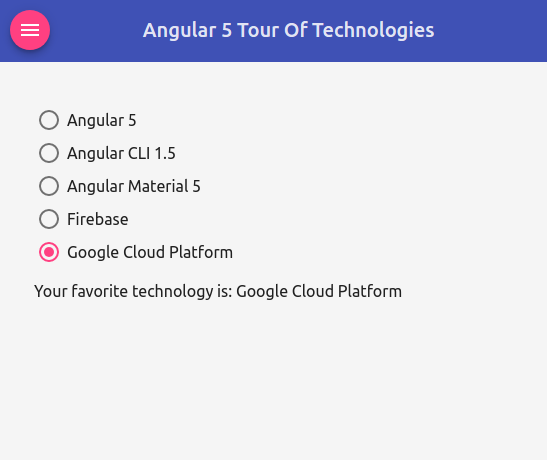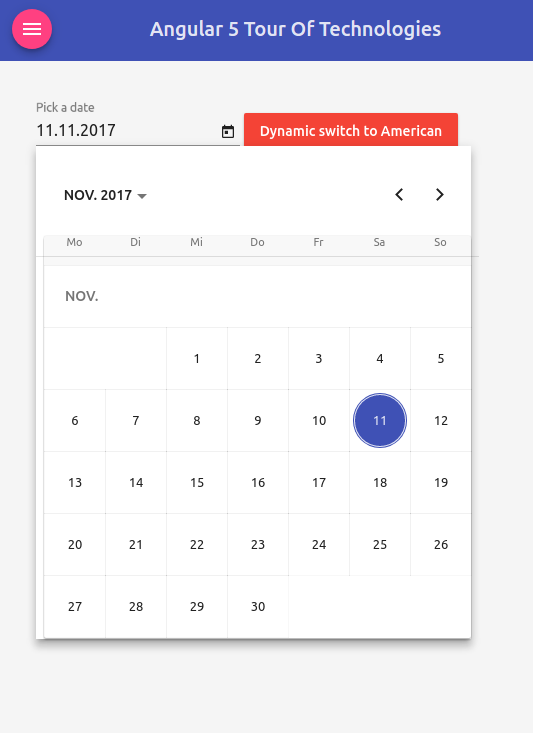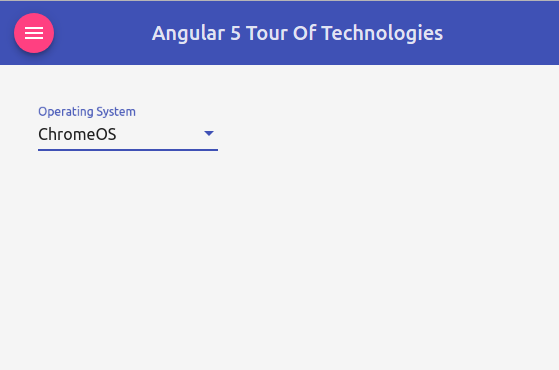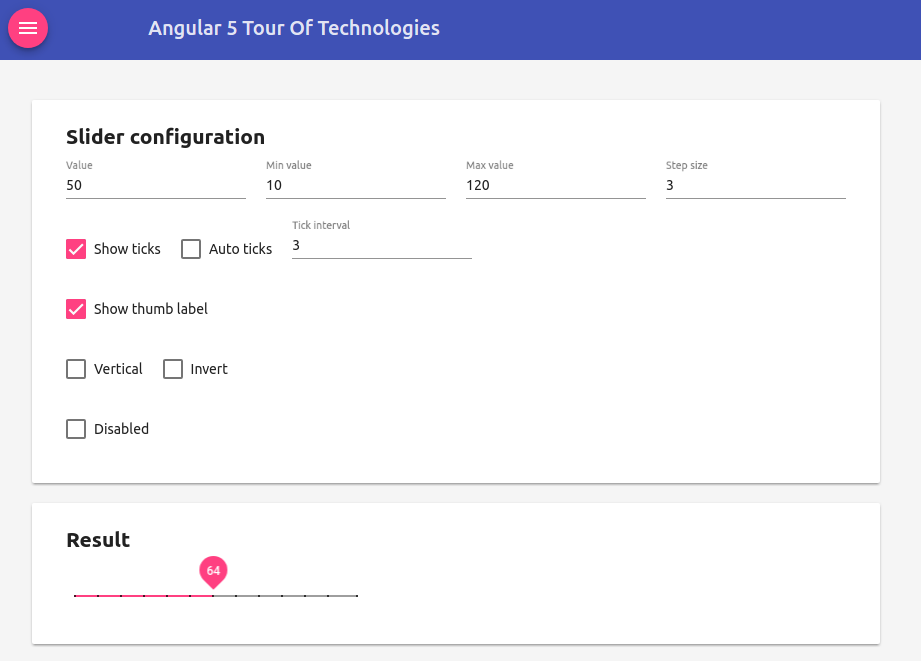24. Angular Material
- Material Design Components Optimized For Angular
- Library of high quality UI Components for Angular
- Internationalized, Clean and Simple API, Customizable, Well Tested, Fast
- Well Documented https://material.angular.io/
- Based on Material Design Language developed by Google since 2014
Install:
npm install --save @angular/material @angular/cdk hammerjs
Styles CSS include a prebuilt-theme:
@import "~@angular/material/prebuilt-themes/indigo-pink.css";
Material Module:
import { NgModule } from '@angular/core';
import {
MatAutocompleteModule,
MatButtonModule,
MatRadioModule,
MatCardModule,
MatCheckboxModule,
MatDatepickerModule,
MatFormFieldModule,
MatIconModule,
MatInputModule,
MatListModule,
MatSelectModule,
MatSidenavModule,
MatSliderModule,
MatSlideToggleModule,
MatStepperModule,
MatToolbarModule
} from '@angular/material';
@NgModule({
imports: [
MatAutocompleteModule,
MatButtonModule,
MatRadioModule,
MatCardModule,
MatCheckboxModule,
MatDatepickerModule,
MatFormFieldModule,
MatIconModule,
MatInputModule,
MatListModule,
MatSelectModule,
MatSidenavModule,
MatSliderModule,
MatSlideToggleModule,
MatStepperModule,
MatToolbarModule
],
exports: [
MatAutocompleteModule,
MatButtonModule,
MatRadioModule,
MatCardModule,
MatCheckboxModule,
MatDatepickerModule,
MatFormFieldModule,
MatIconModule,
MatInputModule,
MatListModule,
MatSelectModule,
MatSidenavModule,
MatSliderModule,
MatSlideToggleModule,
MatStepperModule,
MatToolbarModule
]
})
export class AppMaterialModule { }
AppModule:
import { NgModule } from '@angular/core';
import { BrowserModule } from '@angular/platform-browser';
import { BrowserAnimationsModule } from '@angular/platform-browser/animations';
import { AppMaterialModule } from './app-material.module';
import { FormsModule } from '@angular/forms';
import { AppComponent } from './app.component';
import { PrincessComponent } from './princess.component';
@NgModule({
declarations: [
AppComponent,
PrincessComponent
],
imports: [
BrowserModule,
BrowserAnimationsModule,
FormsModule,
AppMaterialModule
],
providers: [],
bootstrap: [ AppComponent ]
})
export class AppModule { }
Main:
import { enableProdMode } from '@angular/core';
import { platformBrowserDynamic } from '@angular/platform-browser-dynamic';
import 'hammerjs';
import { AppModule } from './app/app.module';
import { environment } from './environments/environment';
if (environment.production) {
enableProdMode();
}
platformBrowserDynamic().bootstrapModule(AppModule);
index:
<!doctype html>
<html lang="en">
<head>
<meta charset="utf-8">
<title>ng5-tour-of-technologies</title>
<base href="/">
<meta name="viewport" content="width=device-width, initial-scale=1">
<link rel="icon" type="image/x-icon" href="favicon.ico">
<link href="https://fonts.googleapis.com/css?family=Ubuntu:400,500,700" rel="stylesheet">
<link href="https://fonts.googleapis.com/icon?family=Material+Icons" rel="stylesheet">
</head>
<body>
<app-root></app-root>
</body>
</html>
Checkboxes:
import { Component } from '@angular/core';
@Component({
selector: 'app-root',
template: `
<mat-toolbar color="primary">
<button (click)="sidenav.toggle()" mat-mini-fab><mat-icon>menu</mat-icon></button>
<span class="fill-remaining-space"></span>
<span>
Angular 5 Tour Of Technologies
</span>
</mat-toolbar>
<mat-sidenav-container>
<mat-sidenav #sidenav mode="side" class="app-sidenav">
<p>Sidenav Content here</p>
</mat-sidenav>
<div class="app-content">
<mat-checkbox
#myCheckbox
[value]="1"
[checked]="isChecked"
(change)="onChange($event)"> Show Me Your Secrets!</mat-checkbox>
<div *ngIf="myCheckbox.checked">
The will to win is nothing without the will to prepare ...
</div>
<app-princess></app-princess>
</div>
</mat-sidenav-container>
`,
styles: [`
:host {
display: flex;
flex-direction: column;
flex: 1;
}
`]
})
export class AppComponent {
title = 'Tour of Technologies';
isChecked = true;
onChange(event) {
console.log(event);
}
}
Let's view the Material Design Look and Feel in our Chromium Web Browser:

import { Component } from '@angular/core';
@Component({
selector: 'app-root',
template: `
<mat-toolbar color="primary">
<button (click)="sidenav.toggle()" mat-mini-fab><mat-icon>menu</mat-icon></button>
<span class="fill-remaining-space"></span>
<span>
Angular 5 Tour Of Technologies
</span>
</mat-toolbar>
<mat-sidenav-container>
<mat-sidenav #sidenav mode="side" class="app-sidenav">
<p>Sidenav Content here</p>
</mat-sidenav>
<div class="app-content">
<mat-radio-group class="sample-radio-group" [(ngModel)]="favoriteTechnology">
<mat-radio-button class="sample-radio-button" *ngFor="let technology of technologies" [value]="technology">
{{ technology }}
</mat-radio-button>
</mat-radio-group>
<div class="sample-selected-value">Your favorite technology is: {{ favoriteTechnology}}</div>
<app-princess></app-princess>
</div>
</mat-sidenav-container>
`,
styles: [`
:host {
display: flex;
flex-direction: column;
flex: 1;
}
.sample-radio-group {
display: inline-flex;
flex-direction: column;
}
.sample-radio-button {
margin: 5px;
}
.sample-selected-value {
margin: 15px 0;
}
`]
})
export class AppComponent {
title = 'Tour of Technologies';
technologies = ['Angular 5', 'Angular CLI 1.5',
'Angular Material 5', 'Firebase', 'Google Cloud Platform'];
}
Let's view the results in Chromium:

AutocompleteComponent:
import { Component } from '@angular/core';
import { FormControl } from '@angular/forms';
import { Observable } from 'rxjs/Observable';
import 'rxjs/add/operator/startWith';
import 'rxjs/add/operator/map';
@Component({
selector: 'app-autocomplete',
template: `
<form class="sample-form">
<mat-form-field class="sample-full-width">
<input matInput placeholder="Country" aria-label="Country"
[matAutocomplete]="auto" [formControl]="countryCtrl">
<mat-autocomplete #auto="matAutocomplete">
<mat-option *ngFor="let country of filteredCountries | async" [value]="country.name">
<img style="vertical-align:middle" aria-hidden src="{{ country.flag}}" height="25">
<span> {{ country.name }} </span>
<small>Capital: {{ country.capital }}</small>
</mat-option>
</mat-autocomplete>
</mat-form-field>
<br>
<mat-slide-toggle [checked]="countryCtrl.disabled"
(change)="countryCtrl.disabled ? countryCtrl.enable() : countryCtrl.disable()">
Disable Input ?
</mat-slide-toggle>
</form>
`,
styles: [`
.sample-form {
min-width: 150px;
max-width: 500px;
width: 100%;
}
.sample-full-width {
width: 100%;
}
`]
})
export class AutocompleteComponent {
countryCtrl: FormControl;
filteredCountries: Observable<any[]>;
countries: any[] = [
{
name: 'Germany',
capital: 'Berlin',
flag: 'https://upload.wikimedia.org/wikipedia/en/b/ba/Flag_of_Germany.svg'
},
{
name: 'Japan',
capital: 'Tokyo',
flag: 'https://upload.wikimedia.org/wikipedia/en/9/9e/Flag_of_Japan.svg'
},
{
name: 'Netherlands',
capital: 'The Hague',
flag: 'https://upload.wikimedia.org/wikipedia/commons/2/20/Flag_of_the_Netherlands.svg'
},
{
name: 'USA',
capital: 'Washington D.C.',
flag: 'https://upload.wikimedia.org/wikipedia/en/a/a4/Flag_of_the_United_States.svg'
}
];
constructor() {
this.countryCtrl = new FormControl();
this.filteredCountries = this.countryCtrl.valueChanges
.startWith(null)
.map(country => country ? this.filterCountries(country) : this.countries.slice());
}
filterCountries(name: string) {
return this.countries.filter(country =>
country.name.toLowerCase().indexOf(name.toLowerCase()) === 0);
}
}
Let's view the running app in our Browser:

DatepickerComponent:
import { Component, ViewEncapsulation } from '@angular/core';
import { MAT_MOMENT_DATE_FORMATS, MomentDateAdapter } from '@angular/material-moment-adapter';
import { DateAdapter, MAT_DATE_FORMATS, MAT_DATE_LOCALE } from '@angular/material/core';
@Component({
selector: 'app-datepicker',
template: `
<mat-form-field>
<input matInput [matDatepicker]="datePicker" placeholder="Pick a date">
<mat-datepicker-toggle matSuffix [for]="datePicker"></mat-datepicker-toggle>
<mat-datepicker #datePicker></mat-datepicker>
</mat-form-field>
<button mat-raised-button color="warn" (click)="american()">
Dynamic switch to American
</button>
`,
providers: [
{ provide: MAT_DATE_LOCALE, useValue: 'de-DE' },
{ provide: DateAdapter, useClass: MomentDateAdapter, deps: [MAT_DATE_LOCALE] },
{ provide: MAT_DATE_FORMATS, useValue: MAT_MOMENT_DATE_FORMATS }
],
styles: [`.mat-calendar { width: 435px !important; height: 493px !important; }`],
encapsulation: ViewEncapsulation.None
})
export class DatepickerComponent {
constructor(private adapter: DateAdapter<any>) { }
american() {
this.adapter.setLocale('en');
}
}
Let's view the results in Chromium:

import { Component } from '@angular/core';
@Component({
selector: 'app-formfields',
template: `
<div class="sample-container">
<mat-form-field>
<input matInput placeholder="What is your name?">
</mat-form-field>
<mat-form-field>
<textarea matInput placeholder="Describe yourself in 3 words ..."></textarea>
</mat-form-field>
<mat-form-field>
<mat-select placeholder="Pick your technology">
<mat-option *ngFor="let technology of technologies" [value]="technology">
{{ technology }}
</mat-option>
</mat-select>
</mat-form-field>
</div>
`,
styles: [`
.sample-container { display: flex; flex-direction: column; }
.sample-container > * { width: 20%; }
`]
})
export class FormFieldsComponent {
technologies = ['Angular 5', 'Angular CLI 1.5', 'Angular Material 5', 'Firebase'];
}
Let's view the results in our Browser:

import { Component } from '@angular/core';
@Component({
selector: 'app-input',
template: `
<form class="sample-form">
<mat-form-field class="sample-full-width">
<input matInput placeholder="Favorite technology" value="Angular 5">
</mat-form-field>
<mat-form-field class="sample-full-width">
<textarea matInput placeholder="Evaluate me ..."></textarea>
</mat-form-field>
</form>
`,
styles: [`
.sample-form {
min-width: 150px;
max-width: 400px;
width: 100%;
}
.sample-full-width {
width: 100%;
}
`]
})
export class InputComponent { }
Let's have a look at the results in Chromium:

SelectComponent:
import { Component, ViewEncapsulation } from '@angular/core';
import { FormControl } from '@angular/forms';
@Component({
selector: 'app-select',
template: `
<mat-form-field>
<mat-select placeholder="Operating System" [formControl]="osColor"
panelClass="sample-panel-{{osColor.value}}">
<mat-option value="red">Linux</mat-option>
<mat-option value="green">ChromeOS</mat-option>
<mat-option value="blue">macOS/X</mat-option>
</mat-select>
</mat-form-field>
`,
styles: [`
.sample-panel-red .mat-select-content { background: rgba(255, 0, 0, 0.5); }
.sample-panel-green .mat-select-content { background: rgba(0, 255, 0, 0.5); }
.sample-panel-blue .mat-select-content { background: rgba(0, 0, 255, 0.5); }
`],
encapsulation: ViewEncapsulation.None
})
export class SelectComponent {
osColor = new FormControl('red');
}
Let's view the results in Chromium:

SliderComponent:
import { Component } from '@angular/core';
@Component({
selector: 'app-slider',
template: `
<mat-card>
<mat-card-content>
<h2 class="sample-h2">Slider configuration</h2>
<section class="sample-section">
<mat-form-field class="sample-margin">
<input matInput type="number" placeholder="Value" [(ngModel)]="value">
</mat-form-field>
<mat-form-field class="sample-margin">
<input matInput type="number" placeholder="Min value" [(ngModel)]="min">
</mat-form-field>
<mat-form-field class="sample-margin">
<input matInput type="number" placeholder="Max value" [(ngModel)]="max">
</mat-form-field>
<mat-form-field class="sample-margin">
<input matInput type="number" placeholder="Step size" [(ngModel)]="step">
</mat-form-field>
</section>
<section class="sample-section">
<mat-checkbox class="sample-margin" [(ngModel)]="showTicks">Show ticks</mat-checkbox>
<mat-checkbox class="sample-margin" [(ngModel)]="autoTicks" *ngIf="showTicks">
Auto ticks
</mat-checkbox>
<mat-form-field class="sample-margin" *ngIf="showTicks && !autoTicks">
<input matInput type="number" placeholder="Tick interval" [(ngModel)]="tickInterval">
</mat-form-field>
</section>
<section class="sample-section">
<mat-checkbox class="sample-margin" [(ngModel)]="thumbLabel">Show thumb label</mat-checkbox>
</section>
<section class="sample-section">
<mat-checkbox class="sample-margin" [(ngModel)]="vertical">Vertical</mat-checkbox>
<mat-checkbox class="sample-margin" [(ngModel)]="invert">Invert</mat-checkbox>
</section>
<section class="sample-section">
<mat-checkbox class="sample-margin" [(ngModel)]="disabled">Disabled</mat-checkbox>
</section>
</mat-card-content>
</mat-card>
<mat-card class="result">
<mat-card-content>
<h2 class="sample-h2">Result</h2>
<mat-slider
class="sample-margin"
[disabled]="disabled"
[invert]="invert"
[max]="max"
[min]="min"
[step]="step"
[thumb-label]="thumbLabel"
[tick-interval]="tickInterval"
[value]="value"
[vertical]="vertical">
</mat-slider>
</mat-card-content>
</mat-card>
`,
styles: [`
.sample-h2 {
margin: 10px;
}
.sample-section {
display: flex;
align-content: center;
align-items: center;
height: 60px;
}
.sample-margin {
margin: 10px;
}
.mat-slider-horizontal {
width: 300px;
}
.mat-slider-vertical {
height: 300px;
}
.mat-card {
width: 800px;
}
`]
})
export class SliderComponent {
private _tickInterval = 1;
autoTicks = false;
disabled = false;
invert = false;
max = 100;
min = 0;
showTicks = false;
step = 1;
thumbLabel = false;
value = 0;
vertical = false;
get tickInterval(): number | 'auto' {
return this.showTicks ? (this.autoTicks ? 'auto' : this._tickInterval) : 0;
}
set tickInterval(val) {
this._tickInterval = Number(val);
}
}
Let's have a look at this baby in our Chromium Browser:

SlideToggle:
import { Component } from '@angular/core';
@Component({
selector: 'app-root',
template: `
<mat-toolbar color="primary">
<button (click)="sidenav.toggle()" mat-mini-fab><mat-icon>menu</mat-icon></button>
<span class="fill-remaining-space"></span>
<span>
Angular 5 Tour Of Technologies
</span>
</mat-toolbar>
<mat-sidenav-container>
<mat-sidenav #sidenav mode="side" class="app-sidenav">
<p>Sidenav Content here</p>
</mat-sidenav>
<div class="app-content">
<div>
<mat-slide-toggle>Slide me</mat-slide-toggle>
</div>
<app-princess></app-princess>
</div>
</mat-sidenav-container>
`,
styles: [`
:host {
display: flex;
flex-direction: column;
flex: 1;
}
`]
})
export class AppComponent {
title = 'Tour of Technologies';
}
Let's view the results in our Browser:









